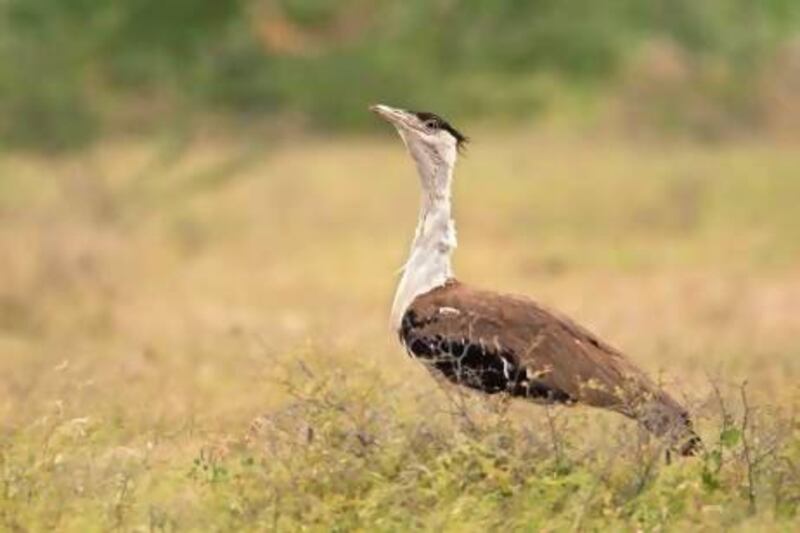NEW DELHI // Habitat destruction and illegal hunting have pushed one of India's most iconic birds to the brink of extinction with fewer than 200 left in the country.
A last-ditch effort to save the Great Indian Bustard, once a candidate for the national bird of India, was launched last week in Rajasthan, with a budget of tens of millions of rupees.
Known for the distinctive black plume on its crown and its long legs, a Great Indian Bustard adult male stands approximately a metre tall, weighs 15 kilograms and has a wingspan of 2.5 metres - making it one of the largest birds capable of flight. The mostly terrestrial bird is found only in India and Pakistan, where the World Wildlife Fund says only a few remain.
In 1972, the renowned ornithologist Salim Ali championed the choice of the Great Indian Bustard as India's national bird. However, officials picked the peacock because, as one story has it, the mispronunciation of the word "bustard" might cause embarrassment.
While they numbered about 1,500 in the mid-1980s, the population has rapidly declined. There were 600 in 2000, between 300 and 350 in 2010 and fewer than 200 today. The birds live in nine sanctuaries in six states and nearly half of the remaining population is in Rajasthan, where the Great Indian Bustard is the state bird.
On Wednesday, state officials announced a plan to spend 120 million rupees (Dh7.72m) to conserve its bustard population.
The expenditure appears modest, but it is a start, said Ramki Sreenivasan, co-founder of Conservation India, an advocacy group, told The National.
"Even seeing a budget to protect a specific bird - I would see that as dramatic," Mr Sreenivasan said. "We should be super-thrilled that the Rajasthan government is doing this and should applaud it."
Conservation India launched a campaign to persuade the Rajasthan government to protect its bustards. More than 1,000 people wrote letters to the Rajasthan chief minister, and these efforts were supplemented, Mr Sreenivasan said, by various conservation groups lobbying politicians.
The primary reason for the dwindling numbers of the bird has been the degradation of India's arid and semi-arid flatlands, which include the birds' natural habitats of grassland and desert.
A 2010 report by three conservation scientists from the Bombay Natural History Society and the Wildlife Institute of India, published in the European Journal of Wildlife Research, pointed to a loss of habitat "in areas where human-induced changes … are most rapid due to intensive agriculture and industrialisation".
"Traditionally, grassland and scrub have been considered as 'wasteland'", so no policy to conserve these habitats has been implemented, the scientists wrote.
Although the Rajasthan government's conservation programme was a good start, bustards should be a concern for the national government, Mr Sreenivasan said.
"There is a need to better manage the grasslands, to treat them for their ecological value," he said. "Once they are given over to agriculture or industry, we lose them irreversibly."
On Thursday, a committee of the National Board of Wildlife met in New Delhi to discuss broader efforts such as grassland preservation and the possibility of breeding the Great Indian Bustard in captivity.
Breeding the bird could prove difficult, said Kedar Gore, the director of the Corbett Foundation, a Mumbai-based conservation non-profit.
"The Great Indian Bustard has very specific requirements as far as breeding grounds are concerned, and it is easily disturbed," Mr Gore said. "In fact, this is why the Gujarat government has banned even photography during the bird's breeding season, which starts in June."
While captive breeding is "definitely an option", he said, "I would always prefer that the habitat be secured first."
"That is the fundamental necessity," he said. "If we can't secure the habitat, there's no point having even 10,000 bustards in captivity, because there will be nowhere to release them."
Another possible reason for the depletion of the Great Indian Bustard has been a spate of hunting tourism in Pakistan. In India, it is illegal to hunt the birds.
Many of Rajasthan's bustards reside in the Desert National Park, near the border with Pakistan, and the birds frequently flit back and forth between the countries.
Pakistan's policy of selling licences to foreign hunters, including several from Arab countries, may be imperilling the Great Indian Bustard, Mr Sreenivasan said.
"The licences are really for the Houbara Bustard, a related bird," he said. "But I find it likely that the hunters also shoot the Great Indian Bustard, and given Pakistan's uncertain conservation climate, it is difficult to press for the protection of the Great Indian Bustard in that country."
ssubramanian@thenational.ae





